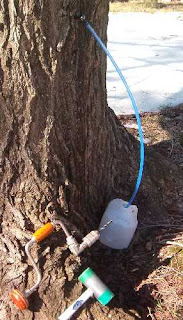Mead and Myths
 I've gone on about mead before here, but not lately. The last frothy carboy I showed was this raspberry melomel from Havoc in Hastings two years ago.
I've gone on about mead before here, but not lately. The last frothy carboy I showed was this raspberry melomel from Havoc in Hastings two years ago.
I'll probably repeat myself somewhat, so if you've read the previous post you can go take a knitting break now.
First off, what is mead? Mead is a beverage made by fermenting honey. According to Louis Lémery's 1745 A Treatise of All Sorts of Foods,
"Mead fortifies the Stomach and Heart, revives the Spirits, helps Refpiration, keeps off the Inconveniencies of a bad Air, and is good for the Wind-Cholic; it opens the Body a little, and is wholefome for thofe that cough, and have the Phthific."Your basic alcoholic beverage is made by taking yeast and giving it some kind of fermentable sugar to consume. The yeast gobbles up the sugar and generates carbon dioxide and alcohol.
There are all kinds of variations on this theme: if the fermentable sugars are from grapes, we call it wine. If they come from grain, it's beer. If the fermentable sugar is honey, the resulting beverage is mead.
Making mead is fairly easy: you need water, honey, and yeast, a nice clean container that will hold them and keep out contaminants, and time. There are lots of variations on mead, and lots of meadmakers who tinker with the process, but those are the basic three.
Each of the three ingredients makes a difference in the end product. Water can be hard or soft. It can contain minerals that will affect the fermentation and the final flavor. Honey can come from any of hundreds of blossoming plants, from buckwheat to blueberry fields. The flavor of the starting honey will affect the end product.
And yeast can make so much difference that I'm giving it its own paragraph! There are so many brewing yeasts out there that it's hard to know where to start. A heavy-duty champagne yeast, for example, probably has a high alcohol tolerance. It will consume a lot of the sugar and leave you with a dry mead that's fairly high in alcohol. A beer yeast, in general, is going to tolerate less alcohol and leave the mead sweeter.
(Go on off to Google and look up "beer yeast". You might be gone for a while, so you might want to take a bathroom break and bring some snacks along!)
I'll take a little side trip myself and say that the same is true for bread yeast. If you make lots and lots of bread with Red Star bread yeast, eventually you start to notice the character of that yeast. Especially if you switch to Fleischmann's, and suddenly your bread tastes different to you.
But wandering back to the subject of mead, let's talk about time. As a person who has done a lot of tatting, and a fair amount of fine-gauge knitting, I've heard "You must have incredible patience" more times than I can count. So I'm not going to say that meadmaking takes patience. It takes time, and storage room, but patience is optional.
How do you get 15-year-old mead without patience? My husband starts some about every year or so. The new bottles go to the back of the shelf. He doesn't drink a whole lot, so eventually he ends up with mead that's been on the shelf for five years or more. And since he doesn't drink a lot, he hands around a fair bit of mead to our friends in the Society for Creative Anachronism and the members of his local homebrewing club.
Now that I've popped the bubble of the patience myth, I have to comment on the idea of going blind from doing fine work.
I asked my eye doctor about this one a couple of years ago, in the course of talking about doing fine work and whether or not it was time to go for bifocals yet. Specifically, I'm talking about Chinese embroidery and the so-called "forbidden stitch". (A couple of good articles are here and here.) My question was "Is it possible to do damage to the eye by doing something like that?" and his short answer was no. It might cause eyestrain (soreness of the focussing muscles of the lens), but not blindness.
However, the most recent time I went in for glasses, I asked about floaters, those annoying specks inside the eye. This time around, I was told that floaters were harmless, BUT if lots of them showed up suddenly, or I saw sparks or streaks of light, to get my eyes checked immediately.
I'm pretty near-sighted. That means my eyes, instead of being round eyeballs, are a little on the egg-shaped side.
The first thing that does is give me no distance vision. Everything outside about six inches is blur zone.
The second thing it does is give me superior close-up vision. I'm told that people with 20-20 vision can't see everything all nice and sharp up close the way I can, poor blind things.
But the third thing, the one the eye doctor warned me about, was that extremely near-sighted people are somewhat more vulnerable to retinal detachment. (Booo!)
So there's my hypothesis: maybe instead of something about the fineness of the embroidery causing blindness, the embroiderers were near-sighted people who unfortunately suffered retinal detachment.
Labels: mead






















